#Animal welfare
Explore tagged Tumblr posts
Text
Btw if you want an example of actually cute and appropriate handling of a baby hippo in an accredited zoo with trained keepers, there’s always Fiona the Hippo at Cincinnati Zoo!
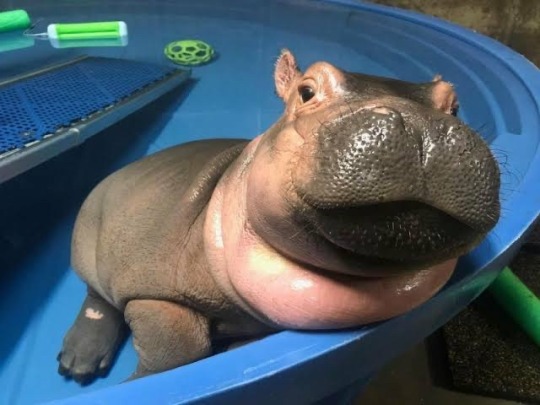
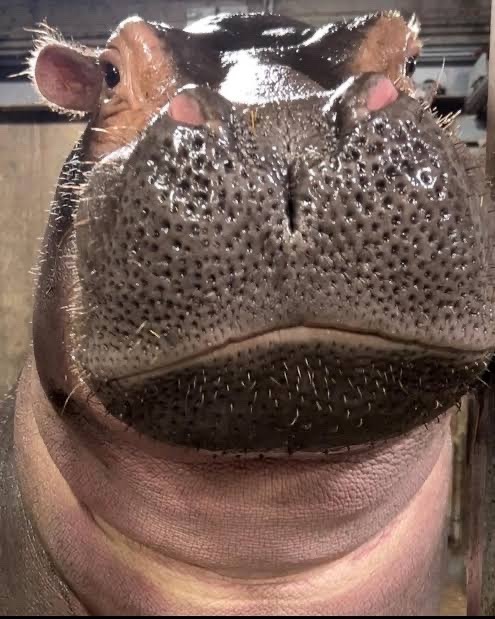
She was born premature and had to be hand raised initially


Fiona felt very safe with her keepers and she would regularly snuggle with them and snooze on their laps. They had to monitor her 24/7 and take feedings in shifts - and it was very uncertain whether she would even survive!
While you might say that it’s hypocritical to support free contact in one situation and not another, this is a situation where free contact was very much okay. They had to support Fiona like this as she was regularly needing medical intervention and needed to be constantly monitored around the clock.
What’s the difference between Fiona and Moo Deng’s situation? Agency and respect. Fiona was never harassed for views or forced into situations she didn’t want to be in.
The content they made with her was showing the process of hand raising a premature baby hippo. Even when they picked her up to put her in her pool she was never madly thrashing to get away.
The goal was always to transition her to be completely hands off and be with her mother Bibi. And her habitat is species appropriate with deep water for swimming in.

She was able to be reintroduced to her mother and grow up engaging in appropriate social behaviours in an enriching and species appropriate habitat.

And she’s now 7 years old and still thriving!
19K notes
·
View notes
Text
“Kill shelters” are the shelters you need to donate to.
“But shrimp!! Kill shelters are evil!!”
No, shut up, listen to me for a second.
“Kill shelter” is a colloquial term used primarily for Town/City (aka municipal) shelters that rely on incredibly limited government grant funding to operate.
These shelters, by the very nature of their existence, DO NOT HAVE the funds to operate like private rescues do.
On top of this, they’re also *legally required* to take in ANY animal that comes to them. Even if they’re full. Or they’ll lose all of their funding.
This is what leads them to needing to euthanize for space. Is euthanizing for space sad? Yes. But due to the current crisis, it’s also NECESSARY.
These shelters are constantly overfull. They’re STRUGGLING. They don’t have the funds to operate properly. And yet these municipal, government funded, struggling shelters are the same ones that are most likely to be providing care for owned animals in the community
Municipal (“kill”) shelters are the ones hosting low cost spay and neuter clinics. They’re the ones discounting vaccination appointments and microchipping. They’re the ones that have pet food banks so struggling pet owners can feed their pets that week.
These shelters are not evil. They’re doing the absolute best they can with the bare minimum funding they get.
These people are incredibly resourceful and care very deeply about the animals in their care. It breaks their heart every time they have to euthanize an animal that couldn’t get adopted.
These underfunded shelters need your money significantly more than that fancy private rescue you see on TikTok or instagram that has a beautiful facility and has never had to euthanize an animal ever.
Support your local shelters and they will give back to the community thousand fold.
Sincerely, an animal welfare student who’s tired of seeing the hardest working professionals shat on because of circumstances they can’t control.
30K notes
·
View notes
Text
"This week was a big win for animals across Mexico.
On December 2, Mexican President Claudia Sheinbaum signed a set of constitutional reforms that will pave the way for a comprehensive federal animal welfare law. The changes represent the first-ever mention of nonhuman animals in the Mexican Constitution, marking a milestone achievement for Mexico’s animal rights movement, which has for years been drawing attention to pervasive animal cruelty and extreme confinement in the country’s growing meat industry.
“This is huge,” says Dulce Ramirez, executive director of Animal Equality Mexico and the vice president of Animal Equality’s Latin American operations. These constitutional changes come after two years of campaigning by animal advocacy organizations, including Igualdad Animal Mexico, Humane Society International/Mexico (HSI/Mexico), and Movimiento Consciencia.
These reforms are internationally unique. While national animal protection laws aren’t uncommon, most countries have no mention of animals in their Constitutions. Constitutions are “a reflection of socially where we are,” Angela Fernandez, a law professor at the University of Toronto, told Vox, making any constitutional reform symbolically a big deal.
Beyond Mexico, nine countries include references to animals in their Constitutions, but those mentions have generally been brief and open to interpretation. “Mexico is different,” Kristen Stilt, faculty director at Harvard Law School’s Animal Law and Policy Program, told Vox. “It’s longer, it’s more specific. It’s in several provisions. It’s not just a general statement.”
Plenty of countries have laws against animal mistreatment, including the US, where all 50 states have an anti-cruelty law, but that doesn’t mean they’ve been particularly effective at stopping violence against animals. Part of the problem is that these laws very often exempt farmed animals such as cows, pigs, and chickens, thereby excluding from protection the overwhelming majority of animals that suffer at human hands. That’s where Mexico’s reforms stand out: They’re intended to protect all animals, including farmed animals and other exploited species.
The reforms in Mexico, the world’s largest Spanish-speaking country, represent a major advancement in the status of animals globally. It could set a precedent for other countries in Latin America, where a vibrant animal rights movement has emerged in recent years, said Macarena Montes Franceschini, a fellow at Harvard Law School’s Animal Law and Policy Program.
Still, as one of the world’s top producers of beef, chicken, pork, dairy, and eggs, Mexico has an intensive animal agriculture industry much like the US, says Antón Aguilar, HSI/Mexico’s executive director. Business interests will undoubtedly want to influence the writing of animal welfare laws that could impact their bottom lines, as they have in the US and elsewhere. The question now is what changes the constitutional reforms will really bring to animal law in Mexico, and how effective they will be.
What will these reforms do?
The reforms comprise changes to three separate articles of Mexico’s Constitution. The most foundational change amends the Constitution’s Article 73, which dictates what Congress has the authority to legislate on. The article now gives the federal government the power to issue laws on animal welfare and protection.
Previously, animal welfare was largely left up to local and state authorities, and the result has been uneven laws and enforcement across the country. While all states in Mexico have animal protection legislation, just three include farmed animals: Hidalgo, Colima, and as of last month, Oaxaca, following pressure from animal advocates. And though Mexico does have a federal law on animal health that focuses on farmed animals and includes some broad mentions of animal welfare, it was created to protect human health rather than animals. The same goes for Mexico’s federal wildlife law, which was written with a focus on sustainability and conservation, rather than on protecting individual animals from cruelty.
Perhaps the most significant part of the reforms is an amendment to Article 4 of Mexico’s Constitution prohibiting the mistreatment of animals and directing the Mexican state to guarantee the protection, adequate treatment, and conservation and care of animals. The language is broad, Ramirez says, but she sees it as a substantial improvement over existing animal welfare laws. She and other advocates worked to ensure that no animals were excluded, particularly given that farmed animals have historically been left out of animal protection.
“It’s really, really important in Mexico to start with this first step — but a big one — because now it’s all animals” that are covered, Ramirez said.
The changes to Articles 4 and 73 tee up the creation of federal legislation on animal welfare. Under these reforms, Mexico’s Congress has been directed to write a first-of-its-kind General Law of Animal Welfare, Care, and Protection, a comprehensive bill that would address and develop regulations preventing the mistreatment of all types of animals, including farmed animals, wildlife, animals in laboratories, and companion animals, Aguilar said.
This general animal welfare law will need to consider animals’“nature, characteristics and links with people,” according to the reform decree released last week. What does this actually mean? Ramirez gave the example of chickens: Part of the natural behavior of these animals is to be able to spread their wings and move around. But if chickens are stuck in cages, as is standard practice on egg factory farms, they can’t do either of those things. Now, the idea is to develop legal criteria that would consider the ability to express these natural behaviors as part of their welfare. (The language could also be interpreted to prioritize human needs, however — particularly the reference to animals’ “links with people.” Animal Equality said it would interpret this through an animal welfare lens, and with the word “link” invoking what humans owe animals.)
Finally, Article 3 of Mexico’s Constitution, which pertains to the education system, was also amended to require that animal welfare be included in school curricula for grade school and high school students. Aguilar said this change could help “attitudes shift and change in a very enduring, long-term way” for future generations. But the new constitutional language is unspecific, and the devil is in the details.
What’s next for animal welfare in Mexico
Advocates in Mexico have two focuses going forward, Ramirez and Aguilar said: shaping the general animal welfare bill into a strong piece of legislation, and working with the Ministry of Education to get meaningful implementation of animal welfare into the national curriculum."
#mexico#north america#animal rights#animal welfare#animal cruelty#farming#farm animals#claudia sheinbaum#good news#hope
483 notes
·
View notes
Text
I think it's a common misconception that domesticating animals is somewhat like enslaving them. It really is more of a symbiotic relationship. No wild animal would have willingly put up with early humans if they didn't get something out of it. Wolves wouldn't have stayed with us and become dogs if they weren't getting food and safety out of it. Many large herbivores that are now domesticated could and would have easily trampled their early human captors or broken their enclosures open if they didn't have a reason to stay. Sometimes individual animals still do if we don't give them what they need.
The animals that have stayed with us for thousands of years have evolved to cooperate with us better. Dogs have additional facial muscles around their eyes that wolves lack in order to mimic human facial expressions. Sheep grow their wool perpetually while their wild counterparts don't because a bigger fleece means they're more likely to be allowed to breed and be kept around. Domestic dairy cows produce much more milk than wild bovine species and domestic hens lay more eggs. Do you know how energy costly producing eggs or milk is for an animal? It's pretty intense! They wouldn't be able to do that if we hadn't given them the food and safety from predators and the elements to.
And we really need to show these animals respect and gratitude for what they give us by taking excellent care of them. They gave up a lot to be with us, often including the means to take care of themselves in the wild. That's a huge reason why I'm not against using animal products, but I hate factory farming. They are still living, breathing creatures with needs and feelings. They deserve a comfortable life and, when the time comes, a humane death.
55K notes
·
View notes
Text
As someone who works w animals “animals are not mindless automatons, they actually do have feelings and individuality and are capable of feeling acute physical and emotional pain and of forming deep attachments with other animals and people” and “animals are not human infants and have a limited capacity to communicate with humans so you have to familiarize yourself with their boundaries bc if they feel threatened or overstimulated they will fall back on their basic instincts and if you fuck around you are going to find out” are statements that can and should coexist
#why is this so hard for ppl to understand#yes they’re capable of genuine love and empathy#no that doesn’t come with an endless supply of patience for human bs or a complex understanding of human motivations#bc they aren’t just here for human consumption they’re literally vibing#animal rights#animal welfare#animal care#animal exploitation
51K notes
·
View notes
Text

The breed standard for modern Persian cats calls for the nose and mouth to be in “vertical alignment” with the eyes 😭
16K notes
·
View notes
Note
hi! can i ask what's ur opinion on giving pets away? not necessarily because u can't afford to care for em anymore but maybe incompatibility of personalities or maybe lifestyles. is it wrong to give ur pet for adoption if u know someone who's better suited for keeping a pet, like emotionally?
This is going to be controversial, but I support making that choice.
There’s a lot of rhetoric lately around how it’s evil and unethical to rehome your pet if you don’t “need to.” And what that does is prioritize human ideology over the actual animal’s well-being.
Pets that aren’t a good match for your home or pets that aren’t really wanted anymore frequently have lower welfare! When caring for an animal becomes a burden or is forced, people end up resenting them, and that means the animal often doesn’t get all of its needs fulfilled. Even if you’re still feeding it and providing appropriate vet care, how likely are you to provide affection or enrichment to an animal you’re tired of being stuck with?
Lifestyle and personality really matter to making sure a pet is a good fit for a home. A dog that alert-barks at every leaf that moves is probably a bad fit for someone who has a chronic migraine syndrome, and they might not know that until the dog has been in the home for weeks and started to open up. A really feisty kitten that requires a ton of play might not do best in the home of someone older who wanted a quiet lap cat. And while you can you do your best to plan to find a compatible animal, you won’t always know ahead of time what issues might arise.
“Forever home” rhetoric is really, really popular and I think it’s very unfair to the animals it is supposed to support. It started with the backlash of seeing animals abandoned inappropriately, and has been heavily reinforced in the public mind because it’s so frequently used to drive fundraising and support for legislation. The whole “forever home” concept communicates to people that getting an animal is an immutable commitment and that if you can’t keep an animal, it is a personal moral failing. It frames human priorities (we think people who get rid of animals are Evil and Bad and should be shunned) as more important than actual welfare needs for individual animals (are they getting the care they need where they are).
Obviously, I don’t support people dumping animals or just getting fad pets they’ll discard immediately, but there’s so many alternate situations that can arise. Even if it’s just “they got a pet and didn’t know what caring for it would take and didn’t want to care for it so they brought it back, how awful” like… okay, I’d like the person to have done more research before they got a pet, but isn’t it better that the animal now has a second chance to go to better home? Knowing what a commitment requires theoretically can be very different than having to actually follow through regularly, and I’d rather see someone maturely acknowledge that having an animal isn’t a good fit than keep it anyway!!
If animals being happy and with all their biological, veterinary, and social needs fulfilled is actually the goal, we need to prioritize their welfare over human opinion. I’d much rather see an animal rehomed responsibly to somewhere it will thrive and be welcomed than see people keep animals they can’t/don’t want to care for out of guilt or shame.
#pets#rehoming animals#animal ethics#animal welfare#there is obviously a lot of nuance to each situation but overall I want pets to be in places that are a good fit#even if that means it isn't where they started out
8K notes
·
View notes
Text

Cat people sure do love making it everyone else's responsibility to keep their outdoor cat safe.
9K notes
·
View notes
Text
Well I certainly didn’t expect to illicit so many questions when I reblogged this post and added some tags about jumping spider content online.
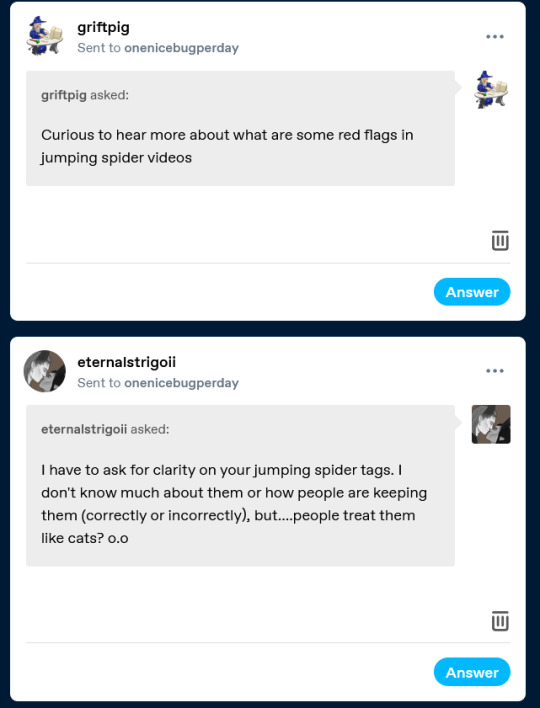
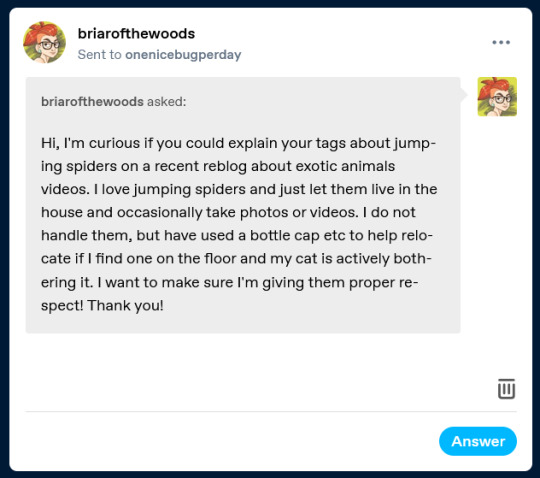
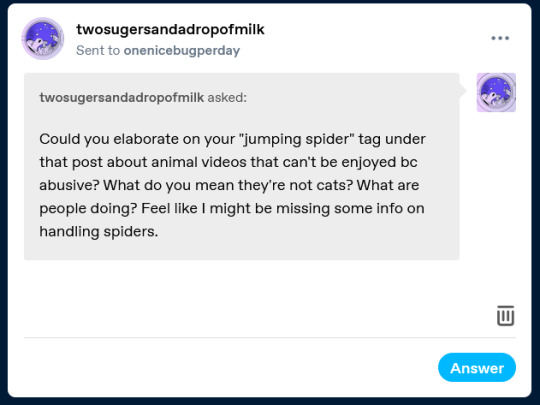
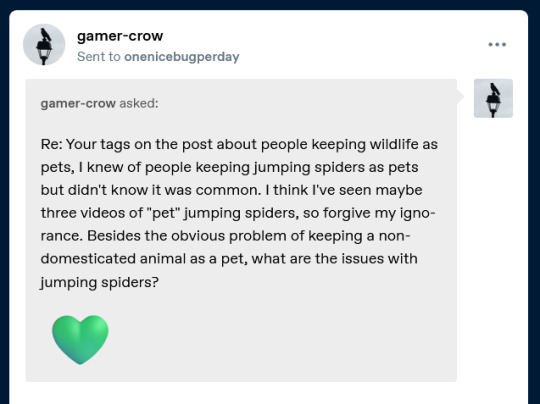

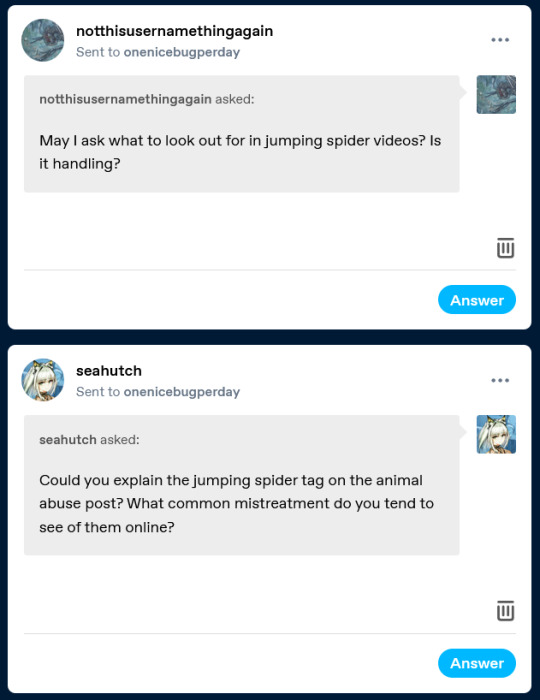


Firstly, let me say there’s nothing wrong with keeping jumping spiders as pets. I have one myself. She’s a captive bred regal jumping spider. She’s currently a bit over two years old. I’ve had other jumping spiders as well, but they passed of old age and in one instance, a failed molt, which is fairly common.
Before and after getting pet jumpers, I joined some jumper groups, read a lot of care guides, and watched a slew of videos about keeping them.
It became obvious pretty quickly that apparently due to their cute fuzzy appearance, large round eyes, and intelligent behavior, people (owners, admirers, and popular content creators) assign human and mammal emotions and behaviors to them, often to their detriment.
I personally believe bugs are complex creatures that can be intelligent and have emotions, but that those emotions and behaviors are NOT analogous to human or mammal behavior and ignoring their natural needs and behaviors means you’re likely not providing proper care for them.
This is mainly about handling. Bugs don’t want to be handled. They get nothing positive out of it emotionally. They don’t want to be pet or cuddle with you. They don’t want to hang out with you. You’re a big scary predator, and it likely wants to get away from you. Forcing handling can stress, injure, or kill them. That’s why I tagged the post (linked above) “your spider is not a cat.” It doesn’t seek affection from you.
I can’t tell you how many posts or videos I saw where people were super upset because they let their jumper out of its enclosure to handle it and it either escaped and got lost or they somehow crushed it and killed or injured it badly. I’ve also seen people chasing their jumper around its enclosure trying to grab it or get it to jump onto their hand when it’s clearly just trying to hide.
As an example, a very common thing I’ve seen in videos about jumpers is people saying when they lift their front legs at you and jump or climb onto you/your hands it’s because they “want uppies” and want to be pet and be close to you. This is a wild misreading of behavior. Sometimes raising the front legs is a defensive display, trying to make itself look larger to scare away a threat. Other times, they’re waving their legs around to sense and feel their environment, or preparing to jump onto something. They are arboreal, and their natural behavior is to find a high vantage point, so climbing onto the big thing (you) nearby is normal. It’s not because it seeks your affection.
Certainly if you DO handle them frequently they can get used to it, and it becomes less stressful for them. But in my opinion the dangers outweigh any positives, and I don’t handle mine. These are wild animals that have not been domesticated, even when captive bred. If you want to give them enrichment, and you should, offer them prey to chase or interesting things to explore in a larger enclosure. For those that do still handle them, I’d encourage you to watch their behavior closely and read the spidery cues they’re giving you rather than assuming they’re feeling what a cute little mammal might be feeling in the same scenario.
I could go on with specifics about certain videos, but I wasn’t planning on writing a huge post and this is already long. Also I’m sure many people would disagree with me about some things I’ve said, and I’m not going to argue about anything. This is just how I feel based on what I’ve seen of online jumping spider content, and it’s why I no longer interact with most of it.
#long post#bug keeping#spider#jumping spider#animal welfare#animal abuse#the more you know#bug death#mentioned
2K notes
·
View notes
Text





So--long story short, a FedEx driver killed a rattlesnake that happened to be on someone's porch, not causing any immediate problems. This is an all too common practice here in the United States, where a significant portion of the population has the backwards idea that "the only good snake is a dead snake" and that the only way to deal with a venomous snake in the proximity of a house, or people in general, is to kill it. Never mind that snakes tend to move on if left alone, and that there are numerous entities that can be contacted to move the snake safely to another place if so desired, and that most bites occur when someone is harassing, handling, or trying to kill the snake.
Dr. Emily Taylor of California Polytechnic State University (@snakeymama on Twitter) has requested that people contact FedEx about their recent commercial glorifying the killing of the snake, which you can view here. I've included both her and my letters to the appropriate folks at FedEx. There are options for both email and snail mail correspondence, and the more people FedEx hears from about this appalling matter, the better.
It's 2024, almost 2025. We have tons of information on rattlesnake behavior and best practices in coexisting with them (to include training your dogs in snake avoidance). We know plenty about the importance they have in local ecosystems, and the devastation that has been done through people slaughtering them, sometimes in the thousands (I wrote about the ongoing problem of rattlesnake roundups and their inherent cruelty here.) There are multiple rattlesnake species that are endangered or otherwise threatened with extinction.
The vast majority of encounters with venomous snakes are benign, and the vast majority of bites come from someone (person, dog, etc.) confronting the snake that was just trying to defend itself. We've spent a lot of time in this country defaulting to killing anything that inconveniences us, but there are better ways to live safely in proximity to wildlife that don't involve violence. It just takes a little more effort and awareness, and most importantly a significant attitude change that no longer vilifies native wildlife simply trying to live their lives.
As Dr. Taylor mentioned, if you want to contact FedEx, here are your options:
"You can help by reposting this or by emailing to express your concern about the commercial: [email protected] and to the CEO at [email protected]. Or send letters to: Fred Smith, CEO Brie Carere, Executive Vice President and Chief Customer Officer Ryan Kelly, Vice President of Marketing FedEx Corporation 942 South Shady Grove Road Memphis, TN 38120 USA"
#animal death#cw animal death#animal cruelty#animal welfare#snakes#rattlesnakes#reptiles#herps#nature#wildlife#animals#ecology#endangered species#conservation#animal behavior#PSA#call to action#please reblog#important
3K notes
·
View notes
Text
Not to be a killjoy (though it is what I do best) but the unsafe and rough handling of a baby Pygmy hippo in a pretty substandard Thai zoo being meme-ed into something funny and cute really shows just how much groupthink plays into public perception of animal welfare.
Moo Deng shows avoidance, threat displays and stress around her keepers that are constantly man-handling her, blasting her with a hose and harassing her. The enclosure is mostly concrete, which is horrible for her soft feet. There looks to be some substrate but there doesn’t seem to be any areas for wallowing or deep water wading.
There’s also very easy access of this hippo to the public with no places to hide. I’d love if someone could shed more light on the enclosures but from what I’ve seen it’s not great.
Also the free contact and forcing into tubs that the keepers do is only going to create an avoidant and potentially aggressive and dangerous Pygmy hippo.
But the public happily overlook that because she’s cute. It’s a similar attitude with seals too.
Stop rewarding bad husbandry with clout. Baby animals deserve agency and respect and to grow up without getting harassed and feeling the need to defend themselves constantly.
33K notes
·
View notes
Text

Brush-tailed bettongs (also known as woylies) once inhabited more than 60% of mainland Australia. However, the European colonization of the country brought with it predatory feral cats and foxes, and the destruction of much of the animal’s native grassland and woodland habitats.
Between 1999 and 2010, the species’ population size declined by 90% – a drastic drop that some research suggests may have resulted from the spread of blood parasites, alongside other factors. Today, the brush-tailed bettong is limited to just a few islands and isolated mainland pockets in Southwestern Australia: a mere 1% of its former range.
Marna Banggara
“We are on a mission, if you like, to bring back some of these native species that have gone missing in our landscape since European colonization,” says Derek Sandow, project manager of Marna Banggara, an initiative dedicated to restoring some of the Yorke Peninsula’s historic ecological diversity.
Formerly known as the “Great Southern Ark,” the project, which was launched in 2019 by the Northern and Yorke Landscape Board, was renamed to honor the region’s native Narungga people, who are heavily involved with the initiative.
“Marna in our language means good, prosperous, healthy, and Banggara means country,” says Garry Goldsmith, a member of the Narungga community who works on the project.
The team initially erected a 25-kilometer predator-control fence across the narrow part of the Yorke Peninsula to create a 150,000-hectare safe haven for the first species to be brought back: the brush-tailed bettong, known as yalgiri to the Narungga people. “We’ve reduced fox and cat impacts to a level that’s low enough for these yalgiri to be reintroduced and for them to actually find refuges, find food, and to survive themselves,” says Sandow.
Between 2021 and 2023, the team introduced almost 200 brush-tailed bettongs to the protected area. Sourcing these individuals from various remaining populations across Western Australia helped to “increase the genetic pool,” says Goldsmith.
EcoSystem Engineers
Brush-tailed bettongs feed on bulbs, seeds and insects, but their primary food source is fungi growing underground; to find it, they must dig. “They’re nature’s little gardeners,” says Sandow, “a single yalgiri can turn over two to six tons of soil per year.”
That’s why they’re the first species being reintroduced to the region, he says. All this digging aerates the soil, improves water filtration and helps seedlings germinate – benefitting other animals that rely on the ecosystem.
#australia#decolonisation#woylies#brush-tailed bettong#bettongs#environmentalism#good news#science#environment#nature#animals#conservation#yalgiri#animal welfare#animal conservation#rewilding
1K notes
·
View notes
Text
Trump may be about to sign the death sentence of the National Institute of Health, and, by extension, the Office of Lab Animal Welfare.
He gutted research animal protections.
Any vertebrate that isn't a mammal will have no rights.
Neither will mice or rats.
If NIH grants are stopped, researchers can't pay anyone. They can't perform research. They can't pay for veterinary services.
They won't be required to provide veterinary services.
The only medical research that will happen will be self funded by big pharma, and they can torture the animals and skew all the lab results that they want.
Just like Musk did to the primates in his neuralink research.
I don't know what's going to happen to me or anyone else at the university where I work. My job is to make sure the animals are treated humanely and to provide veterinary care. I'm especially scared about what's going to happen to those research animals if veterinary staff gets laid off. The USDA only covers mammals, and it doesn't even cover all of them. Every rat I've ever made a tiny paper gift box full of marshmallows for, every mouse I've ever watched grow up, every rodent I've ever separated from an aggressive dominant brother and then treated their tiny wounds, they have no protections if NIH goes down. Decades of research into humane handling, euthanasia, and animal behavior will be tossed aside and wasted.
Please, do everything you can. Protest. Contact your representatives. Anything you can do. Do it for science, for medicine, for people's lives, for people's jobs, and for the animals.
Edit: thank you to everyone who's spreading this, but please reblog the updated reblog that I have pinned to my profile. The NIH is no longer frozen, but "indirect expenses" limits is just as big a threat to lab animal welfare, scientific integrity, and people's jobs as an NIH freeze.
#nih#cdc#us politics#national institutes of health#research#department of health and human services#public health#donald trump#OLAW#office of lab animal welfare#usda#us department of agriculture#animal rights#animal care#animal health#science#cancer research#disease research#public health service#elon musk#presidential election of 2024#fuck elon#fuck trump#president trump#trump 2024#dump trump#infectious diseases#animal welfare#animal welfare regulations#mouseblr
1K notes
·
View notes
Text
In the past month, I’ve seen:
A “community cat” with a fractured jaw, respiratory distress, and massive hemorrhaging after being hit by a car
A kitten with one fractured leg, one severely lacerated, and another degloved (skin removed) with torn ligaments after being found in the street
A young cat unresponsive with an uncontrollably high fever due to a tick-borne disease
A beautiful, well-loved kitten who stopped breathing due to a suspected brain bleed and was unable to be revived while preparing for surgery to repair a shattered pelvis after being hit by a car
Again, all these happened in the past month. And these are just the really bad ones I can think of off the top of my head.
All these cats, except one, are now dead.
But yeah, free-roaming is good for cats. They know how to take care of themselves.
#note none of these problems are specific to the us#last I checked there are cars in the uk#maybe not that particular strain of tick borne disease#but definitely cars#the one that’s alive?#my colleague and I had to call a humane fund to get funding for her $4000 surgery#and that’s with a discount#cats#outdoor cats#animal death#animal welfare#vet med#veterinarian#vetblr
2K notes
·
View notes
Text
honestly people are way more ignorant about the welfare of the animals than they think they are
animal rights activists are even worse regarding that, because instead of actually learning about what an animal needs and how it behaves they rely solely on how they *think* animals feel and need
and it's the reason why the public views feeding and interacting with wild animals as "being good and kindhearted :) " and keeping animals in zoos as "poor animals suffering in cramped cages >:( "
and it kills animals
#i have to gather more energy to properly continue#i want to write about this but thoughts aren't organised at all#animal welfare#animal behavior
2K notes
·
View notes